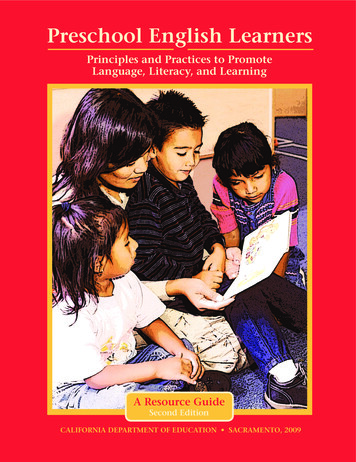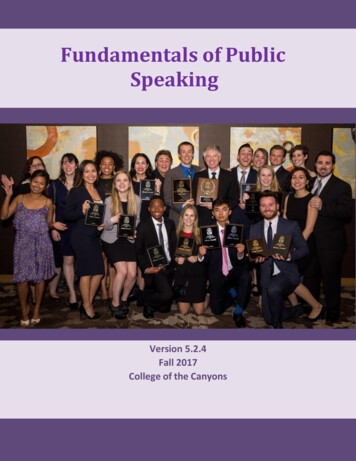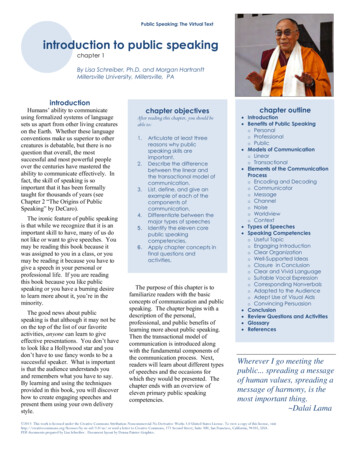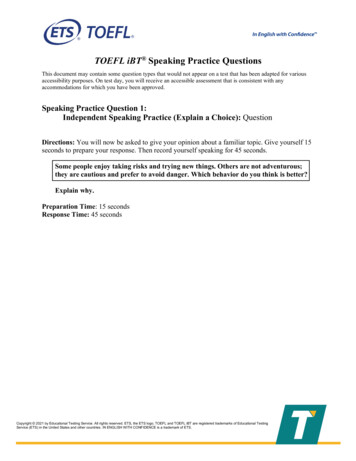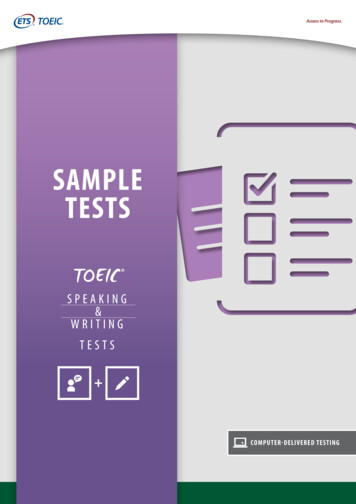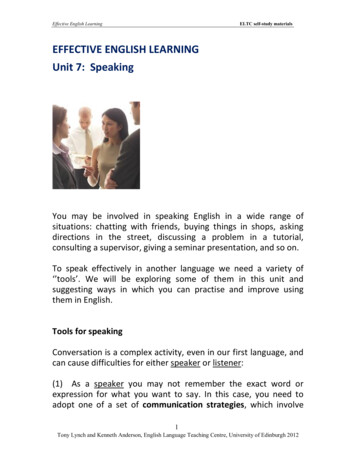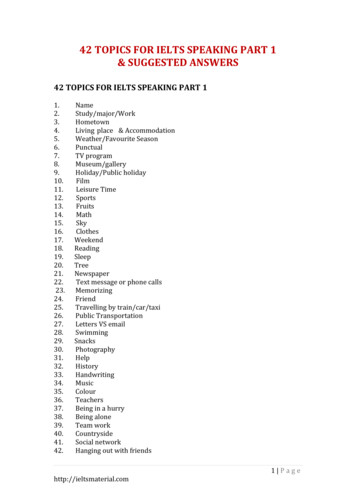
Transcription
Стр. 1 из 185A guide to speaking and pronouncing colloquialAmerican EnglishSecond Edition Ann CookIllustrated by Holly Forsyth Audio by Busy Signal StudiosBARRON'S
Стр. 2 из 185This book is dedicated to Nate Cook.Also, my special thanks for their extensive contributions to my editor, DimitryPopow, Carolyn Jaeckin, Dr. Maria Bruno, Karina Lombard, Dr. Hyouk-KeunKim, Ph.D., Karl Althaus, Adrian Wong, Sergey Korshunov, and Jerry Danielsonat Busy Signal Studios. Copyright 2000 by Ann Cook, http://www.americanaccent.comPrior edition copyright 1991 by Ann Cook.Portions of this book were previously published by Matrix Press. Copyright 1989 by Matrix PressAll right reserved.No part of this book may be reproduced in any form by photostat, microfilm, xerography, or any other means, orincorporated into any information retrieval system, electronic or mechanical, without the written permission of thepublisher.All inquiries should be addressed to: Barron's Educational Series, Inc. 250 Wireless BoulevardHauppauge,NY11788 http://www. barronseduc. comInternational Standard Book No. 0-7641-1429-8 Library of Congress Catalog Card No. 99-75495PRINTED IN THE UNITED STATES OF AMERICA 987654321Желательно иметь шрифт WP PhoneticTable of ContentsRead This FirstCD 1 Track 1What Is Accent?Can I Learn a New Accent?Accent versus Pronunciation"Which Accent Is Correct?""Why Is My Accent So Bad?"Less Than It Appears . More Than It AppearsLanguage Is Fluent and FluidA Few Words On PronunciationCD 1 Track 2Tense Vowels? Lax Vowels?Voiced Consonants? Unvoiced Consonants?Pronunciation PointsTelephone TutoringPreliminary Diagnostic AnalysisCD 1 Track 3Chapter 1 American IntonationThe American Speech MusicCD 1 Track 4What to Do with Your Mouth to Sound AmericanAmerican Intonation Do's and Don'tsWhat Exactly Is Staircase Intonation?Three Ways to Make IntonationExercise 1-1: Rubber Band Practice with Nonsense SyllablesStaircase IntonationStatement Intonation with NounsStatement Intonation with PronounsExercise 1-3; Noun and Pronoun IntonationStatement Versus Question Intonation CD 1 Track 10Emotional or Rhetorical Question IntonationExercise 1-4: Sentence Intonation TestExercise 1-5: Four Main Reasons for Intonation1. New Information2. Opinion3. Contrast4. Can'tExercise 1-6: Pitch and Meaning ChangeExercise 1-7: Individual PracticeExercise 1-8: Meaning of "Pretty"Exercise 1-9: InflectionExercise 1-10; Individual PracticeCD 1 Track 5CD 1 Track 6CD 1 Track 8CD 1 Track 9CD 1 Track 11CD 1 Track 12CD 1 Track 13CD 1 Track 14CD 1 Track 15CD 1 Track 16CD 1 Track 17
Стр. 3 из 185Overdo ItWe All Do ItExercise 1-11: TranslationIntonation ContrastExercise 1-12: Create Your Own Intonation ContrastExercise 1-13: Variable StressExercise 1 -14: Make a Variable Stress SentenceApplication of IntonationExercise 1 -15: Application of StressHow You Talk Indicates to People How You AreExercise 1-16: Paragraph Intonation PracticeExercise 1-17: Staircase Intonation PracticeExercise 1-18: Reading with Staircase IntonationExercise 1-19: Spelling and NumbersExercise 1-20; Sound/Meaning Shifts CD 1 Track 29Exercise 1-21: Squeezed-Out Syllables CD 1 Track 30CD 1 Track 18CD 1 Track 19CD 1 Track 20CD 1 Track 21CD 1 Track 22CD 1 Track 23CD 1 Track 24CD 1 Track 25CD 1 Track 26CD 1 Track 27CD 1 Track 28Syllable Stress CD 1 Track 31Syllable Count Intonation PatternsExercise 1-22: Syllable Patterns1 Syllable2 SyllablesExercise 1-22: Syllable Patterns continued3 SyllablesExercise 1-22; Syllable Patterns continued4 SyllablesExercise 1-23; Syllable Count TestCD 1 Track 32CD 1 Track 32CD 1 Track 32CD 1 Track 33Complex IntonationWord Count Intonation PatternsCD 1 Track 34Exercise 1-24: Single-Word PhrasesCD 1 Track 35Two-Word PhrasesDescriptive PhrasesCD Track 36Exercise 1-25: Sentence Stress with Descriptive PhrasesExercise 1 -26: Two Types of Descriptive PhrasesExercise 1 -26: Two Types of Descriptive Phrases continuedExercise 1-27: Descriptive Phrase Story—The Ugly DucklingCD 1 Track 40Set PhrasesCD 1 Track 37CD 1 Track 38CD1 Track 38CD1 Track 39A Cultural Indoctrination to American NormsExercise 1-28: Sentence Stress with Set PhrasesExercise 1-29: Making Set PhrasesExercise 1-30: Set Phrase Story—The Little Match GirlContrasting a Description and a Set PhraseExercise 1-31: Contrasting Descriptive and Set PhrasesExercise 1-32: Two-Word StressSet PhraseDescriptive PhraseSummary of Stress in Two-Word PhrasesFirst WordSecond WordNationalitiesExercise 1-33; Nationality Intonation Quiz CD 2 Track 11. an Américan guy2. an American restaurant3. Américan food4. an American teacher5. an Énglish teacherExercise 1-34: Contrasting Descriptive and Set PhrasesExercise 1-35: Contrast of Compound NounsExercise 1-36: Description and Set Phrase TestExercise 1-37: Descriptions and Set Phrases—GoldilocksGrammar in a NutshellCD 1 Track 41CD 1 Track 42CD 1 Track 43CD 1 Track 44CD 1 Track 45CD 2 Track 2CD 2 Track 3CD 2 Track 4CD 2 Track 5CD 2 Track 6Everything You Ever Wanted to Know About Grammar. But Were Afraid to UseExercise 1-38; Consistent Noun Stress in Changing Verb TensesExercise 1-39: Consistent Pronoun Stress In Changing Verb TensesCD 2 Track 7CD 2 Track 8
Стр. 4 из 185Exercise 1-40: Intonation in Your Own SentenceCD 2 Track 9CD 2 Track 9Exercise 1 -40: Intonation in Hour Own Sentence continued1-40: Intonation in Your Own Sentence continued CD 2 Track 9CD 2 Track 10Exercise 1-41: Supporting WordsExercise 1 -42: Contrast PracticeCD 2 Track 11CD 2 Track 12Exercise 1 -43; Yes, You Can or No, You Can't?Exercise 1 -44: Building an Intonation SentenceCD 2 Track 13Exercise 1 -46: Regular Transitions of Nouns and VerbsCD 2 Track 15CD 2 Track nExercise 1-47: Regular Transitions of Adjectives and VerbsExercise 1-48; Regular Transitions of Adjectives and VerbsCD 2 Track 17The Miracle TechniqueCD 2 Track 18A Child Can Learn Any LanguageExercise 1 -49: Tell Me Wədai Say!Exercise 1-50: Listening for Pure SoundsExercise 1-51 : Extended Listening PracticeReduced SoundsCD 2 Track 19CD 2 Track 21CD 2 Track 22CD 2 Track 24Reduced Sounds Are "Valleys"Exercise 1-52; Reducing ArticlesExercise 1-53: Reduced SoundsExercise 1-53: Reduced Sounds continuedExercise 1-53; Reduced Sounds continuedExercise 1-53: Reduced Sounds continuedExercise 1-53: Reduced Sounds continuedExercise 1 -53: Reduced Sounds continuedExercise 1-54: Intonation and Pronunciation of "That"Exercise 1-55: Crossing Out Reduced SoundsExercise 1-56; Reading Reduced SoundsCD 2 Track 25CD 2 Track 26CD 2 Track 26CD 2 Track 26CD 2 Track 26CD 2 Track 26CD 2 Track 26CD 2 Track 27CD 2 Track 28CD 2 Track 29Word Groups and PhrasingCD 2 Track 30Pauses for Related Thoughts, Ideas, or for BreathingExercise 1-57: PhrasingCD Track 31Exercise 1-58: Creating Word GroupsExercise 1-59: Practicing Word GroupsCD 2 Track 34Exercise 1-60: Tag EndingsIntonationPronunciationChapter 2. Word ConnectionsExercise 2-1 : Spelling and PronunciationCD 2 Track 32CD 2 Track 33CD 2 Track 35CD 2 Track 36Liaison Rule 1 : Consonant / VowelExercise 2-2: Word ConnectionsCD 2 Track 37CD 2 Track 38Exercise 2-3: Spelling and Number ConnectionsWhat's the Difference Between a Vowel and a Consonant?Exercise 2-4: Consonant / Vowel Liaison PracticeCD 2 Track 39Exercise 2-4: Consonant / Vowel Liaison Practice continuedCD 2 Track 39Liaison Rule 2: Consonant / ConsonantCD 2 Track 40Exercise 2-5: Consonant /Consonant LiaisonsExercise 2-6: Consonant / Consonant LiaisonsCD 2 Track 41ConsonantsExercise 2-7: Liaisons with TH CombinationExercise 2-8: Consonant / Consonant Liaison PracticeLiaison Rule 3: Vowel / VowelExercise 2-9: Vowel / Vowel Liaison PracticeLiaison Rule 4: T, D, S, or Z YExercise 2-10; T, D, S, or Z Y LiaisonsT Y CHExercise 2-10: T, D, S, or Z Y Liaisons continuedD Y JS Y SHZ Y ZHExercise 2-10: T, D, S, or Z Y Liaisons continuedExercise 2-11:T, D, S, or Z Y Liaison PracticeExercise 2-12; Finding Liaisons and GlidesExercise 2-13: Practicing LiaisonsCD 2 Track 42CD 2 Track 43CD 2 Track 44CD 2 Track 45CD 2 Track 45CD 2 Track 45CD 2 Track 46CD 2 Track 47CD 3 Track 1
Стр. 5 из 185Exercise 2-14: Additional Liaison PracticeCD 3 Track 2CD 3 Track 3Exercise 2-15: Colloquial Reductions and LiaisonsExercise 2-15: Colloquial Reductions and Liaisons continued CD 3 Track 3Spoon or Sboon?Exercise 2-16: Liaison StaircasesCD 3 Track 4Chapter 3. Cat? Caught? Cut?CD 3 Track 5The [æ] SoundThe [ä] SoundThe Schwa [ə] SoundSilent or Neutral?Vowel ChartExercise 3-1 : Word-by-Word and in a SentenceExercise 3-2: Finding [æ], [ä], and [ə] SoundsExercise 3-3: Vowel-Sound DifferentiationExercise 3-4: Reading the [æ] SoundCD 3 Track 6CD 3 Track 7CD 3 Track 8CD 3 Track 9The Tæn MænExercise 3-5: Reading the [ä] SoundCD strack 10A Lät of Läng, Hät Walks in the GardenExercise 3-6: Reading the [ə] SoundCD 3 Track 11What Must the Sun Above Wonder About?Chapter 4. The American TExercise 4-1 ; Stressed and Unstressed TExercise 4-2: Betty Bought a Bit of Better ButterCD 3 Track 12Betty Bought a Bit of Better ButterExercise 4-3: Rute 1—Top of the StaircaseExercise 4-3; Rule 1—Top of the Staircase continuedExercise 4-4: Rule 2—Middle of the StaircaseExercise 4-5: Rule 3—Bottom of the StaircaseExercise 4-5: Rule 3—Bottom of the Staircase continuedExercise 4-6: Rule 4—"Held T" Before NExercise 4-7: Rule 5—The Silent TExercise 4-9: Karina's T ConnectionsExercise 4-10: Combinations in ContextExercise 4-11 : Voiced and Unvoiced Sounds with TExercise 4-12: Finding American T Sounds CD 3 Track 24Voiced Consonants and Reduced Vowels1.2.3.4.CD 3 Thick 13CD 3 Track 14CD 3 Track 15CD 3Track 15CD 3 Track 16CD3 Track 17CD 3 Track 17CD 3 Track 18CD 3 Track 19CD 3 Track 21CD 3 Track 2:Reduced vowelsVoiced consonantsLike sound with like soundR'lææææææææææxChapter 5. The ElL and Foreign Speakers of EnglishCD 3 Track 25Location of Language in the MouthThe Compound Sound of LL Compared with T, D, and NT and DNExercise 5-1 : Sounds Comparing L with T, D, and NT/D PlosiveExercise 5-1 ; Sounds Comparing L with T, D and N continuedExercise 5-2; Sounds Comparing L with T, D, and NCD 3 Track 26CD 3 Track 26CD 3 Track 27What Are All Those Extra Sounds I'm Hearing?Exercise 5-3: Final El with SchwaExercise 5-4: Many Final ElsExercise 5-5: Liaise the LsExercise 5-6: Finding L SoundsExercise 5-7: Silent LsExercise 5-8: Hold Your Tongue!Exercise 5-9: Little LolaExercise 5-11 : Final L PracticeExercise 5-12: Thirty Little Turtles In a Bottle of Bottled WaterExercise 5-13: Speed-readingExercise 5-14: Tandem ReadingVoice QualityCD 3 Track 40CD 3 Track 28CD 3 Track 29CD 3 Track 30CD 3 Track 31CD3Track32CD 3 Track 33CD 3 Track 34CD 3 Track 36CD 3 Track 37CD 3 Track »CD 3 Track 39
Стр. 6 из 185Exercise 5-15: Shifting Your Voice PositionChapter 6. The American RThe Invisible RExercise 6-1: R Location PracticeExercise 6-2 : Double Vowel with RExercise 6-3: How to Pronounce Troublesome RsExercise 6-4: Zbigniew's Epsilon ListExercise 6-5: R CombinationsExercise 6-6; The Mirror StoreExercise 6-7: Finding the R SoundTelephone TutoringFollow-up Diagnostic AnalysisCD 3 Track 41CD 3 Track 42CD 3 Track 43CD 3 Track 44CD 3 Track 45CD 3 Track 46CD 3 Track 47CD 3 Track 48CD 3 Track 49CD 3 Track 50Chapters 1-6 Review and ExpansionIntonationMiscellaneous Reminders of IntonationLiaisons and GlidesCat? Caught? Cut?The American TThe ElThe American RApplication ExercisesReview Exercise 1 : To have a friend, be a friend. CD 3 Track 51Review Exercise 2: To have a friend, be a friend.CD 3 Track 521.2.3.4.5.6.7.IntonationWord groupsLiaisonsæ, ä, əThe American TThe American RCombination of concepts 1-6Review Exercise 3: Get a Better Water Heater!Review Exercise 4: Your Own SentenceReview Exercise 5: Varying EmotionsReview Exercise 5: Varying Emotions continuedReview Exercise 6: Realty? Maybe!Review Exercise 7: Who Did It? I Don't Know!Review Exercise 7: Who Did It? I Don't Know! continuedReview Exercise 8: Russian RebellionCD 3 Track 53CD 3 Track 54CD 3 Track 55CD 3 Track 55CD 3 Track 56CD 3 Track 57CD 3 Track 57CD 3 Track 58Two-Word PhrasesReview Exercise A: Contrasting Descriptive and Set Phrases CD 3 Track 59Review Exercise B: Intonation Review TestCD 3 Track 60Three-Word PhrasesReview Exercise C: Modifying Descriptive PhrasesCD 3 Track 61Review Exercise D; Modifying Set PhrasesCD 3 Track 62CD 3 Track 63Review Exercise E: Two- and Three-Word Set PhrasesReview Exercise F: Three-Word Phrase SummaryCD 3 Track 64Review Exercise G: Three-Word Phrase Story—Three Little Pigs CD 4 Track 1Review Exercise H: Sentence Balance—GoldilocksCD 4 Track 2Four-Word PhrasesReview Exercise I: Multiple Modifiers with Set Phrases CD 4 Track 3CD 4 Track 4Review Exercise J: Compound intonation of NumbersReview Exercise K: Modify ing Three-Word Set PhrasesCD 4 Track 5CD 4 Treck 6Review Exercise L: Four-Word Phrase Story—Little Red Riding HoodReview Exercise M: Building Up to Five-Word PhrasesCD 4 Track 7CD 4 track 8Review Exercise 9: Ignorance on ParadeReview Exercise 10: Ignorance on Parade Explanations.CD 4 Track 9Review Exercise 10: Ignorance on Parade Explanations continued CD 4 Track 9Chapter 7. Tee AitchExercise 7-1 : The Throng of ThermometersCD 4 Track 10CD 4 Track 11Run Them All Together [runnemälld'gether]Anticipating the Next WordExercise 7-2: Targeting The TH SoundExercise 7-3: Tongue TwistersChapter 8. More Reduced SoundsCD 4 Track 12CD 4 Track 13CD 4 Track 14
Стр. 7 из 185Exercise 8-1 : Comparing [u] and [ü]CD 4 Track 15CD 4 Track 16Exercise 8-2: Lax VowelsExercise 8-3; Bit or Beat?CD 4 Track 17CD 4 Track 18Exercise 8-4: Bit or Beat? Bid or Bead?Exercise 8-5: Tense and Lax Vowel ExerciseCD 4Track 19CD 4 Track 20Exercise 8-6: The Middle "I" ListExercise 8-7: Reduction OptionsCD 4 Track 21CD 4 Track 22Exercise 8-8: Finding Reduced SoundsCD 4 Track 23Exercise 8-9: How Much Wood Would a Woodchuck Chuck?CD 4 Track 24Exercise 8-10; Büker Wülsey's CükbükCD 4 Track 25Exercise 8-11: A True FoolIntonation and AttitudeExercise 8-12: Nonverbal IntonationChapter 9. "V" as in VictoryExercise 9-1 : Mind Your VeesExercise 9-2: The Vile VIPExercise 9-3: Finding V SoundsCD 4 Track 26CD 4 Track 27CD 4 Track 28CD 4 Track 29CD 4 Track 30Chapter 10. S or Z?Exercise 10-1 : When S Becomes ZCD 4 Track 31Exercise 10-2: A Surly Sergeant Socked an Insolent SailorCD 4 Track 32CD 4 Track 33Exercise 10-3: Allz Well That Endz WellExercise 10-4: Voiced and Unvoiced Endings in the Past Tense CD 4 Track 34CD 4 Track 35Exercise 10-5: Finding S and Z SoundsExercise 10-4; Application Steps with S and ZCD 4 Track 36CD 4 Track 37Exercise 10-7: Your Own Application Steps with S and ZChapter 11. Tense and Lax VowelsExercise 11-1; Tense VowelsExercise 11 -2: Tense Vowels Practice ParagraphExercise 11-3: Lax VowelsExercise 11-4: Lax Vowels Practice ParagraphExercise 11-5: Take a High-Tech TackExercise 11 -6: Pick a PeakCD 4 Track 38CD 4 Track 39CD 4 Track 40CD 4 Track 41CD 4 Track 42CD 4 Track 43Grammar in a Bigger NutshellExercise 11-7: Compound Nouns and Complex VerbsCD 4 Track 44Exercise 11-7: Compound Nouns and Complex Verbs continued CD 4 Track 44Exercise 11-7; Compound Nouns and Complex Verbs continued CD 4Track 44Exercise 11-8: Your Own Compound NounsCD 4 Track 45Exercise 11-9: Your Compound Nouns and Complex VerbsCD 4 Track 46Exercise 11-10: Practical Application—U.S./Japan Trade Friction CD 4 Track 47The Letter AExercise 11-11: Presidential Candidates' DebateCD 4 Track 48Chapter 12. Nasal ConsonantsExercise 12-1: Nasal ConsonantsExercise 12-2: Ending Nasal ConsonantsExercise 12-3: Reading Nasal Consonant SoundsExercise 12-4: Finding [n] and [ng] SoundsCD 4 Track 49Chapter 13. Throaty ConsonantsCD 4 Track 50CD 4 Track 51CD 4 Track 52CD 4 Track 53Exercise 13-1: Throaty ConsonantsCD 4 Track 55Exercise 13-2: The Letter XExercise 13-3: Reading the H, K, G, NG, and R soundsCD 4 Track 54CD 4 Track 56HKGNGRExercise 13-4: Glottal Consonant Practice ParagraphTelephone TutoringFinal Diagnostic AnalysisChapters 1-13. Review and ExpansionCD 4 Track 57CD 4 Track 58Review Exercise 1-1: Rubber Band Practice with Nonsense SyllablesReview Exercise 1-2; Noun IntonationReview Exercise 1-3: Noun and Pronoun IntonationReview Exercise 1-4: Sentence Intonation TestReview Exercise 1-6: Pitch and Meaning Change
Стр. 8 из 185Review Exercise 1-7: Individual PracticeReview Exercise 1-8: Meaning of "Pretty," "Sort of," "Kind of," and "Little"Review Exercise 1-9: InflectionReview Exercise 1-10: Individual PracticeReview Exercise 1-11: TranslationReview Exercise 1-12: Create Your Own Intonation ContrastReview Exercise 1-13: Variable StressReview Exercise 1-14: Make a Variable Stress SentenceReview Exercise 1-15: Application of StressReview Exercise 1-17: Staircase Intonation PracticeReview Exercise 1-18: Reading with Staircase IntonationReview Exercise 1-19: Spelling and NumbersReview Exercise 1-20: Sound/Meaning ShiftsReview Exercise 1-21: Squeezed-Out SyllablesReview Exercise 1-22: Syllable PatternsReview Exercise 1-25: Sentence Stress with Descriptive PhrasesReview Exercise 1-23: Syllable Count TestReview Exercise 1-24: Single-Word PhrasesReview Exercise 1-26: Two Types of Descriptive PhrasesReview Exercise 1-27: Descriptive Phrase Story—Snow White and The Seven DwarvesReview Exercise 1-28: Sentence Stress with Set PhrasesReview Exercise 1-29: Making Set PhrasesReview Exercise 1-30: Set Phrase Story—Our MailmanReview Exercise 1-31: Contrasting Descriptive and Set PhrasesReview Exercise 1-32: Two-Word StressReview Exercise 1-34: Contrasting Descriptive and Set PhrasesReview Exercise 1-35: Contrast of Compound NounsReview Exercise 1-36: Description and Set Phrase TestReview Exercise 1-38: Consistent Noun Stress in Changing Verb Tenses (5 disk)Review Exercise 1-39: Consistent Pronoun Stress in Changing Verb TensesReview Execise 1-40: Intonation in Your Own SentenceReview Exercise 1-41: Supporting WordsReview Exercise 1-42: Contrast PracticeReview Exercise 1-43: Yes, You Can or No, You Can't?Review Exercise 1-44: Building an Intonation SentenceReview Exercise 1-45: Building Your Own intonation SentencesReview Exercise 1-46: Regular Transitions of Nouns and VerbsReview Exercise 1-47: Regular Transitions of Adjectives and VerbsReview Exercise 1-48; Regular Transitions of Adjectives and VerbsReview Exercise 1-51; Extended Listening PracticeReview Exercise 1-53: Reduced SoundsReview Exercise 1-55: Crossing Out Reduced SoundsReview Exercise 1-56: Reading Reduced SoundsReview Exercise 1-57: PhrasingReview Exercise 1-60: Tag EndingsReview Exercise 2-1: Spelling and PronunciationReview Exercise 2-4: Consonant / Vowel Liaison PracticeReview Exercise 2-8: Consonant/Consonant Liaison PracticeReview Exercise 2-9: Vowel / Vowel Liaison PracticeReview Exercise 2-11: T, D, S, or Z Y Liaison PracticeReview Exercise 2-12: Finding Liaisons and GlidesReview Exercise 2-13: Practicing LiaisonsReview Exercise 3-1: Word-by-Word and in a SentenceReview Exercise 3-3: Vowel-Sound DifferentiationReview Exercise 3-4: Finding the æ, ä, ə SoundsReview Exercise 3-5: Reading the [æ] SoundReview Exercise 3-6: Reading the [ä] SoundReview Exercise 3-7: Reading the [ə] SoundReview Exercise 4-1 : Stressed and Unstressed TReview Exercise 4-3: Rule 1—Top of the StaircaseReview Exercise 4-4: Rule 2—Middle of the StaircaseReview Exercise 4-5: Rule 3—Bottom of the StaircaseReview Exercise 4-6: Rule 4—"Held T" Before NReview Exercise 4-7: Rule 5—The Silent TReview Exercise 4-10: T Combinations in ContextReview Exercise 4-11: Voiced and Unvoiced Sounds with T
Стр. 9 из 185Review Exercise 5-2: Sounds Comparing L with T, D, and NReview Exercise 5-3: Final El with SchwaReview Exercise 5-4: Many Final ElsReview Exercise 5-5: Liaise the LsReview Exercise 5-7: Silent LsReview Exercise 5-8: Hold Your Tongue!Review Exercise 5-9: Bill and EllieReview Exercise 5-11 : Final L PracticeReview Exercise 5-12: A Frontal Lobotomy?Review Exercise 5-13: Speed-readingReview Exercise 5-14: Tandem ReadingReview Exercise 6-1 : R Location PracticeReview Exercise 6-2: Double Vowel Sounds with RReview Exercise 6-3: How to Pronounce Troublesome RsReview Exercise 6-4: Zbignlew's Epsilon ListReview Exercise 6-5: R CombinationsReview Exercise 6-6: Roy the RancherReview Exercise C: Modifying Descriptive PhrasesReview Exercise D: Modifying Set PhrasesReview Exercise E:Two- and Three-Word Set PhrasesReview Exercise F: Three-Word Phrase SummaryReview Exercise I: Multiple Modifiers with Set PhrasesReview Exercise J: Compound Intonation of NumbersReview Exercise K: Modifying Three-Word Set PhrasesReview Exercise L: Three Word Phrase Story—The Amazing Rock SoupReview Exercise M: Building Up to Five-Word PhrasesReview Exercise 7-1: The ThingNoun Intonation SummaryRule 1: New InformationRule 2: Old InformationRule 3: ContrastRule 4: OpinionRule 5: Negation (Can't)Review Exercise 8-1 : Comparing [u] and [ü]Review Exercise 8-2: Lax VowelsReview Exercise 8-4: Bit or Beat? Bid or Bead?Review Exercise 8-5: Tense and Lax Vowel Review ExerciseReview Exercise 8-6: Middle "I" ListReview Exercise 8-10: [ü] ParagraphReview Exercise 8-11: [u] ParagraphReview Exercise 9-1: Mind Your VeesReview Exercise 10-1: S or Z?Review Exercise 10-2: Sally at the SeashoreReview Exercise 10-3: Fuzzy WuzzyReview Exercise 11-1: Tense VowelsReview Exercise 11-3: Lax VowelsReview Exercise 11-7: Compound Nouns and Complex VerbsReview Exercise 12-1: Nasal ConsonantsReview Exercise 12-2: Ending Nasal ConsonantsReview Exercise 12-3: Reading Nasal Consonant SoundsReview Exercise 13-1: Throaty ConsonantsReview Exercise 13-2: The Letter XReview Exercise 13-3: Reading the H, K, G, NG, and R soundsNationality GuidesImportant PointChinese Intonation SummaryChineseIntonationLocation of the LanguageJapaneseIntonationLiaisonsPronunciation
Стр. 10 из 185The Japanese R The American TLocation of the LanguageSpanishIntonationLiaisonsWord EndingsPronunciationThe Spanish S The American S, But.The Spanish R The American TThe -ed EndingThe Final TThe Spanish D The American Th (voiced)The Spanish of Spain Z or C The American Th (unvoiced)The Spanish I The American Y (not j)The Doubled Spanish A Sound The American O, All or AW SpellingThe Spanish O The American OULocation of the ion of the LanguageRussianIntonationLiaisonsPronunciationThe Russian R The American ТFrenchIntonationLiaisonsPronunciationLocation in the tonationWord ConnectionsPronunciationThe Korean R The American TAnswer KeyExercise 1-4: Sentence Intonation TestExercise 1-15: Application of StressExercise 1-17: Staircase Intonation PracticeExercise 1-29: Making Set PhrasesExercise 1-35: Contrast of Compound NounsExercise 1-36: Description and Set Phrase TestExercise 1-48: Regular Transitions of Adj. and VerbsExercise 1-23: Syllable Count TestExercise 1-51: Extended Listening PracticeExercise 1-60: Tag EndingsExercise 2-4: Consonant / Vowel LiaisonsExercise 2-8: Consonant / Consonant LiaisonsExercise 2-9: Vowel / Vowel LiaisonsExercise 2-11 : T, D, S, or Z LiaisonsExercise 2-12: Finding Liaisons and GlidesExercise 2-16: Liaison StaircasesExercise 3-2: Finding [æ], [ä] and [ə] Sounds
Стр. 11 из 185Exercise 4-12: Finding American T SoundsExercise 1-51: Extended Listening PracticeExercise 5-6: Finding L SoundsExercise 6-7: Finding the R SoundReview Exercise B: Intonation Review TestExercise 7-2: Targeting the TH SoundExercise 8-8: Finding Reduced SoundsExercise 9-3: Finding V SoundsExercise 10-5: Finding S and Z SoundsExercise 11-2 and 11-4: Finding Tense (a, e, æ) and Lax Vowel Sounds (i, ə)Exercise 12-4: Finding [n] and [ng] SoundsExercise 13-4: Glottal Consonant PracticeReview Section Answer KeyReview Ex. 1-4: Sentence Intonation TestReview Ex. 1-35: Contrast of Compound NounsReview Ex. 1-36: Description and Set Phrase TestReview Ex. 1-48: Adjective and Verb TransitionsReview Ex. 1-51: Extended Listening PracticeReview Ex. 1-60: Tag EndingsReview Ex. 2-4: Cons. / Vowel Liaison PracticeReview Ex. 2-8: Cons. / Cons. Liaison PracticeReview Ex. 2-9: Vowel / Vowel Liaison PracticeReview Ex. 2-11 : T, D, S, or Z Liaison PracticeReview Ex. 2-12: Finding Liaisons and GlidesReview Ex. 3-4: Finding the æ, ä, ə, and d SoundsIndexSymbolsABCDEFGHIKLМNОPQRSTUVWYXZTable of ContentsIntroduction: Read This First. ivA Few Words On Pronunciation . viiPreliminary Diagnostic Analysis . xChapter 1 American Intonation .1Staircase Intonation . 5Syllable Stress . 19Complex Intonation. 23Two-Word Phrases. 24Grammar in a Nutshell . 35The Miracle Technique . 46Reduced Sounds . 48
Стр. 12 из 185Word Groups and Phrasing. 56Chapter 2 Word Connections. 59Chapter 3 Cat? Caught? Cut? . 71Chapter 4 The American T . 77Chapter 5 The El.85Voice Quality . 94Chapter 6 The American R . 95Follow-up Diagnostic Analysis . 100Chapters 1-6 Review and Expansion . 101Two-, Three- and Four-Word Phrases. 108Chapter 7 Tee Aitch . 118Chapter 8 More Reduced Sounds . 121Middle I List. 125Intonation and Attitude . 128Chapter 9 "V" as in Victory. 129Chapter 10 S or Z? . 131Chapter 11 Tense and Lax Vowels . 135Grammar in a Bigger Nutshell. 138Chapter 12 Nasal Consonants . 145Chapter 13 Throaty Consonants. 147Final Diagnostic Analysis. 150Chapters 1-13 Review and Expansion . 151Nationality Guides. 172Chinese . 173Japanese. 177Spanish . 180Indian. 183Russian . 186French. 188German . 189Korean . 191Answer Key. 193Index. 197Read This FirstCD 1 Track 1Welcome to American Accent Training. This book and CD set is designed to get you started on yourAmerican accent. We'll follow the book and go through the 13 lessons and all the exercises step bystep. Everything is explained and a complete Answer Key may be found in the back of the text.What Is Accent?Accent is a combination of three main components: intonation (speech music), liaisons (wordconnections), and pronunciation (the spoken sounds of vowels, consonants, and combinations). Asyou go along, you'll notice that you're being asked to look at accent in a different way. You'll alsorealize that the grammar you studied before and this accent you're studying now are completelydifferent.Part of the difference is that grammar and vocabulary are systematic and structured— the letter ofthe language. Accent, on the other hand, is free form, intuitive, and creative— more the spirit of thelanguage. So, thinking of music, feeling, and flow, let your mouth relax into the American accent.Can I Learn a New Accent?Can a person actually learn a new accent? Many people feel that after a certain age, it's just not
Стр. 13 из 185possible. Can classical musicians play jazz? If they practice, of course they can! For your Americanaccent, it's just a matter of learning and practicing techniques this book and CD set will teach you. Itis up to you to use them or not. How well you do depends mainly on how open and willing you areto sounding different from the way you have sounded all your life.A very important thing you need to remember is that you can use your accent to say what you meanand how you mean it. Word stress conveys meaning through tone or feeling, which can be muchmore important than the actual words that you use. We'll cover the expression of these feelingsthrough intonation in the first lesson.You may have noticed that I talk fast and often run my words together. You've probably heardenough "English-teacher English"—where . everything . is . pronounced without having to listentoo carefully. That's why on the CDs we're going to talk just like the native speakers that we are, in anormal conversational tone.Native speakers may often tell people who are learning English to "slow down" and to "speakclearly." This is meant with the best of intentions, but it is exactly the opposite of what a studentreally needs to do. If you speak fairly quickly and with strong intonation, you will be understoodmore easily. To illustrate this point, you will hear a Vietnamese student first tryin
A guide to speaking and pronouncing colloquial American English Second Edition Ann Cook Illustrated by Holly Forsyth Audio by Busy Signal Studios BARRON'S Стр. 1 из 185. This book is dedicated to Nate Cook. . A .
